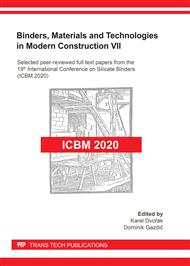p.21
p.28
p.34
p.40
p.47
p.53
p.59
p.65
p.71
The Effect of Opal-Containing Rocks on the Properties of Lightweight Oil-Well Cement
Abstract:
When constructing deep wells for oil and gas production in difficult geological conditions, special lightweight oil-well cements are used. To reduce the density and water separation of the cement slurry as well as to increase the strength, corrosion resistance of cement stone and the quality of well cementing, opal-containing rocks, fly ash, microsphere and other lightening additives are introduced into the cement composition. The influence of sedimentary rocks, such as opoka, tripoli, and diatomite containing from 43 to 81% amorphous silica on the grindability, rheological and physical-mechanical properties of lightweight oil-well Portland cement has been studied. The twelve cement compositions with different content of additives (from 30 to 45%) that meet the requirements of the standard for density, spreadability, water separation, thickening time and flexural strength were selected. The introduction of 45% diatomite or tripoli significantly reduces the duration of cement grinding, provides the cement slurry with water-cement ratio of 0.9 with better density and flexural strength, respectively, 1480 kg/m3 and 1.1–1.5 MPa.
Info:
Periodical:
Pages:
47-52
Citation:
Online since:
October 2021
Authors:
Keywords:
Price:
Сopyright:
© 2021 Trans Tech Publications Ltd. All Rights Reserved
Share:
Citation:


